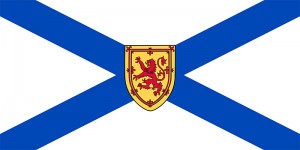According to recent calculations and estimates, the population of Nova Scotia is 921,727, making it the 2nd most densely populated province in Canada.
Currently, Nova Scotia’s population makes up approximately 2.8% of the Canadian national population. With a 0.9% population growth, Nova Scotia is the seventh most populated Canadian province, after Ontario (1), Quebec (2), British Columbia (3), Alberta (4), and Manitoba (5), and Saskatchewan (6).
Nova Scotia Land Area
The land area is 55,284 km^2, or 21,345 mi^2, making Nova Scotia the second smallest province by land mass, after Prince Edward Island.
Nova Scotia makes up approximately 0.6% of Canada’s entire area and has a water area of 1,946 km^2, or 751 mi^2.
Nova Scotia Borders
The mainland of Nova Scotia is a peninsula surrounded by primarily the Atlantic Ocean. Nova Scotia is surrounded by four major bodies of water: Gulf of St. Lawrence (north), Bay of Fundy (west), Gulf of Maine (southwest), and Atlantic Ocean (southeast). Nova Scotia consists of Cape Breton Island and Stable Island, the latter being known for shipwrecks. Although surrounded by the ocean, Nova Scotia’s climate is more continental than it is maritime. However, the proximity to the ocean does contribute to the temperature extremes and cold winter/warm summer trends.
 Nova Scotia Capital
Nova Scotia Capital
Halifax is the largest city and also the capital of Nova Scotia, with a population of 390,096 according to the 2011 Census. Halifax is actually the largest city in eastern Canada. Halifax has been ranked as the “4th best place to live in Canada in 2012,” and has placed first in “large cities by quality of life” and second in “large cities in North America of the future.” Those who live in Halifax call themselves Haligonians.
Nova Scotia Federal Representation
Saskatchewan holds 11 of the 308 House of Commons seats, thus making up 3.6% of the total percentage.
Saskatchewan holds 10 of the 105 Senate Seats making up 9.5% of the total.
Nova Scotia Economic Statistics
Nova Scotia is a major economic center in eastern Canada, and has quite a concentration of private business and government buildings. One of the main employers is the Department of National Defense of Canada and other various government departments. The Port of Halifax contributes to prosperous economic trade. However, agriculture, fishing, mining, forestry, and natural gas are all important major resources in the rural areas of Nova Scotia.
Nova Scotia Historical Population Statistics
| Year | Population |
| 1901 | 459,574 |
| 1911 | 492,338 |
| 1921 | 523,837 |
| 1931 | 512,846 |
| 1941 | 577,962 |
| 1951 | 642,584 |
| 1961 | 737,007 |
| 1971 | 788,965 |
| 1981 | 847,442 |
| 1991 | 899,942 |
| 1996 | 909,282 |
| 2001 | 908,007 |
| 2006 | 913,462 |
| 2011 | 921,727 |
Interactive Canadian Province Population Map
Other Resources
To learn more about the population of Nova Scotia, click here
Learn more about Prince Edward Island Population



